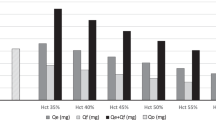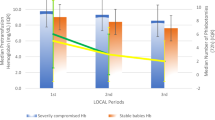Abstract
Given the urgency of double volume exchange transfusion (ExT) in an infant with intermediate to advanced stages of acute bilirubin encephalopathy (ABE), it has been suggested that emergency release uncross-matched packed red blood cells (ER-PRBC) be used. The efficacy of an ExT in removing bilirubin from the brain, however, is a direct function of the mass of albumin exchanged. The very low albumin content of ER-PRBC may fail to be neuroprotective. Predicted changes in total serum bilirubin (TSB), serum albumin, the bilirubin/albumin (B/A) ratio, plasma volume (PV), and bilirubin equilibration from the extravascular space during ER-PRBC ExT are described. ExT using ER-PRBC is efficacious in lowering the TSB. However, this result is falsely reassuring as significant concurrent serum albumin loss, resultant hypoalbuminemia, contraction of PV, limited bilirubin clearance from the extravascular space, and sustained B/A ratio elevations above recommended ExT treatment thresholds suggest that bilirubin neurotoxicity will continue.
This is a preview of subscription content, access via your institution
Access options
Subscribe to this journal
Receive 12 print issues and online access
$259.00 per year
only $21.58 per issue
Buy this article
- Purchase on Springer Link
- Instant access to full article PDF
Prices may be subject to local taxes which are calculated during checkout



Similar content being viewed by others
References
Watchko JF. Exchange transfusion in the management of neonatal hyper-bilirubinemia. In: Maisels MJ, Watchko JF, editors. Neonatal jaundice. London: Harwood Academic Publishers; 2000. pp. 169–76.
Maisels MJ, Stevenson DK, Watchko JF, McDonagh AF. Phototherapy and other treatments. In: Stevenson DK, Maisels MJ, Watchko JF, editors. Care of the jaundiced neonate. New York: McGraw Hill; 2012. pp. 195–227.
American Academy of Pediatrics, Subcommittee on Hyperbilirubinemia. Management of hyperbilirubinemia in the newborn infant 35 or more weeks of gestation [published correction in Pediatrics. 2004;114: 1138]. Pediatrics. 2004;114:297–316.
Van Praagh R. Diagnosis of kernicterus in the neonatal period. Pediatrics. 1961;28:870–76.
Volpe J. Neurology of the newborn. Philadelphia: W.B. Saunders; 1995. pp. 503–5.
Iskander I, Gamaleldin R, El Houchi S, El Shenawy A, Seoud I, El Gharbawi N, et al. Serum bilirubin and bilirubin/albumin ratio as predictors of bilirubin encephalopathy. Pediatrics. 2014;134:e1330–9.
El Houchi SE, Iskander I, Gamaleldin R, El Shenawy A, Seoud I, Abou-Youssef H, et al. Prediction of 3- to 5-month outcomes from signs of acute bilirubin toxicity in newborn infants. J Pediatr. 2017;183:51–5.
Harris MC, Bernbaum JC, Polin JR, Zimmerman R, Polin RA. Developmental follow-up of breastfed term and near-term infants with marked hyperbilirubinemia. Pediatrics. 2001;107:1075–80.
Hansen TWR, Nietsch L, Norman E, Bjerre JV, Hascoet JM, Mrehil K, et al. Reversibility of acute intermediate phase bilirubin encephalopathy. Acta Paediatr. 2009;98:1689–94.
Sims ME. Legal briefs: kernicterus still preventable. NeoReviews. 2011;12:e727–730.
Sisson TR, Whalen LE, Telel A. A comparison of effects of whole blood and sedimented erythrocytes in exchange transfusion. Pediatrics. 1958;21:81–89.
Chitty HE, Ziegler N, Savoia H, Doyle LW, Fox LM. Neonatal exchange transfusions in the 21st century: a single hospital study. J Paediatr Child Health. 2013;49:825–32.
Valaes T. Bilirubin distribution and dynamics of bilirubin removal by exchange transfusion. Acta Paediatr. 1963;52 Suppl 149:1–115.
Sproul A, Smith L. Bilirubin equilibration during exchange transfusion in hemolytic disease of the newborn. J Pediatr. 1964;65:12–26.
Brown AK, Zuelzer WW, Robinson AR. Studies in hyperbilirubinemia. II. Clearance of bilirubin from plasma and extra vascular space in newborn infants during exchange transfusion. Am J Dis Child. 1957;93:274–86.
Watchko JF. 50 years ago, in the Journal of Pediatrics: bilirubin equilibration during exchange transfusion in hemolytic disease of the newborn. J Pediatr. 2014;165:64.
Johnson L, Bhutani VK, Karp K, Sivieri EM, Shapiro SM. Clinical report from the pilot US kernicterus registry (1992 to 2004). J Perinatol. 2009;29 Suppl 1:S25–S45.
Jain R, Jarosz C. Safety and efficacy of AS-1 red blood cell use in neonates. Transfus Apher Sci. 2001;24:111–5.
Maisels MJ, Bhutani VK, Bogen D, Newman TB, Stark AR, Watchko JF. Hyperbilirubinemia in the newborn infant ≥ 35 weeks’ gestation: an update with clarifications. Pediatrics. 2009;124:1193–98.
Ahlfors CE. Criteria for exchange transfusion in jaundiced newborns. Pediatrics. 1994;93:488–94.
Hulzebos CV, Dijk PH, van Imhoff DE, Bos AF, Lopriore E, Offrings M, et al. The bilirubin albumin ratio in the management of hyperbilirubinemia in preterm infants to improve neurodevelopmental outcome: a randomized controlled trial – the BARTrial. PLoS ONE. 2014;9:e99466.
Bryla DA. Development, design, and sample composition. Pediatrics. 1985;75 Suppl:387–92.
Watchko JF. Bilirubin induced neurotoxicity in the preterm neonate. Clin Perinatol. 2016;43:297–311.
Watchko JF. Refractory causes of kernicterus in developedcountries: can we eradicate G6PD deficiency triggered and low-bilirubin kernicterus?. Curr Pediatr Rev. 2017;13:159–68.
Watchko JF, Maisels MJ. The enigma of low bilirubin kernicterus in premature infants: why does it still occur, and is it preventable? Semin Perinatol. 2014;38:397–406.
Govaert P,Lequin M,Swarte R,Robben S,De Coo R,Weisglas-Kuperus N, et al. Changes in globus pallidus with (pre) term kernicterus. Pediatrics. 2003;112:1256–63.
Ahlfors CE, Wennberg RP, Ostrow JD, Tiribelli C. Unbound (free) bilirubin: improving the paradigm for evaluating neonatal jaundice. Clin Chem. 2009;55:1288–99.
Josephson CD, Meyer E. Neonatal and pediatric transfusion practice. In: Fung MK, Grossman BJ, Hillyer CD, Westhoff CM, editors. American Association of Blood Banks technical manual. Bethesda: AABB Press; 2014. pp. 571–97.
Strauss RG. Data-driven blood banking practices for neonatal RBC transfusions. Transfusion. 2000;40:1528–40.
Butwick AJ, Goodnoiugh LT. Transfusion and coagulation management in major obstetric hemorrhage. Curr Opin Anesthesiol. 2015;28:275–84.
Kaplan M, Merlob P, Regev R. Israel guidelines for the management of neonatal hyperbilirubinemia and prevention of kernicterus. J Perinatol. 2008;28:389–97.
Mreihil K, McDonagh AF, Nakstad B, Hansen TWR. Early isomerization of bilirubin in phototherapy of neonatal jaundice. Pediatr Res. 2010;67:656–9.
Jasprova J, Dal Ben M, Vianello E, Goncharova I, Urbanova M, Vyroubalova K, et al. The biological effects of bilirubin photoisomers. PLoS ONE. 2016;11:e0148126.
Kitchen WH, Krieger VI, Smith MA. Human albumin in exchange transfusion. A quantitative study of the influence of added albumin on bilirubin removal. J Pediatr. 1960;57:876–83.
Shahian M, Moslehi MA. Effect of albumin administration prior to exchange transfusion in term neonates with hyperbilirubinemia – a randomized controlled trial. Indian Pediatr. 2010;47:241–4.
Mukhopadhyay K, Chowdhary G, Singh P, Kumar P, Narang A. Neurodevelopmental outcome of acute bilirubin encephalopathy. J Trop Pediatr. 2010;56:333–6.
Acknowledgements
The author thanks Darrell Triulzi, Mark Yazer, Angelo Lamola, Chuck Ahlfors, Sara Watchko, and Richard Wennberg for their insightful suggestions and comments and acknowledges the generous support of the 25 Club of Magee-Womens Hospital and the Mario Lemieux Foundation.
Author information
Authors and Affiliations
Corresponding author
Ethics declarations
Conflict of interest
Dr. Watchko reports serving as a consultant in legal cases related to neonatal jaundice. No other potential conflict of interest relevant to this article was reported.
Rights and permissions
About this article
Cite this article
Watchko, J.F. Emergency release uncross-matched packed red blood cells for immediate double volume exchange transfusion in neonates with intermediate to advanced acute bilirubin encephalopathy: timely but insufficient?. J Perinatol 38, 947–953 (2018). https://doi.org/10.1038/s41372-018-0168-x
Received:
Revised:
Accepted:
Published:
Issue Date:
DOI: https://doi.org/10.1038/s41372-018-0168-x



